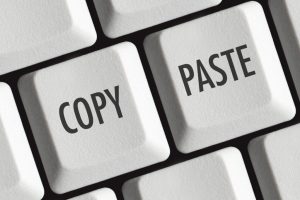
Plagiarism is a form of scientific misconduct defined as authoring ideas or words produced by someone else or from one’s own previous publications and attempting to publish such work without properly citing the original author and publication. Plagiarism is easy for writers to avoid by simply not copying any printed sources and by writing original text in one’s own words, and, if paraphrasing, citing the source.
Unfortunately, these simple rules seem to be either forgotten or ignored by many authors, as instances of plagiarism have become all too common throughout the scientific world.
A charitable view is that authors who are guilty of plagiarism are ignorant of what constitutes plagiarism. Science adheres to certain standards of investigation that are invariant with respect to geography, social convention or personal opinion. Because publishing and disseminating ideas are central to the scientific endeavour and the rules governing writing and publishing data are sacrosanct, it is crucial that we all agree and adhere to common standards regarding plagiarism.
As editors and publishers of the Annals of Biomedical Engineering we take seriously our role as a primary gatekeeper of scientific integrity. We do not tolerate plagiarism or any kind of associated misconduct, and urge our viewers and readers to bring to our attention ethical questions or simply queries of what constitutes plagiarism in our manuscripts and published articles. We Also expect our authors to exercise stringent care to avoid plagiarism.
- Don’t copy. Mimicking verbatim words from any other paper or book (even if it’s your own previously published work) is not good writing. Very short quotations are acceptable when contained within quotation marks and citing the source immediately following the quote. It should go without saying that copying without quotation marks and lacking appropriate citations is blatant plagiarism, but unfortunately, this does occur.
- Write in your own words. Write out all your own ideas without using someone else’s words or even another’s writing style to help you out. This means that you should generally avoid paraphrasing as much as possible. Paraphrasing, or rewriting someone else’s text in your own words, is acceptable only if it occurs minimally in the text (e.g., a paragraph) and the original source is cited at the end of the paraphrased passage. The easiest way to avoid any concerns about plagiarism here is to not paraphrase. Use your own, original ‘voice’ to convey your ideas. Do not blend original and borrowed text without citing the borrowed text.
- When in doubt, cite. If you find yourself citing excessively because of this, it could be any indication that you’re not writing enough in your own words. This is a sign you should consider rewriting your paper. Common words and phrases do not need to be cited or put into quotation marks, but any discussion of commonly understood concepts must be properly cited.
- Don’t recycle images, figures, tables or text from one of your own previously published papers without citing. In general, it’s better to not republish a figure that you’ve published before. But if you must, cite the original paper in the figure or table caption and make sure you mention in the text that it was from your earlier publication and obtain permission if you have not retained the copyrights. Do not recycle text from one paper to the next. Write new text for each paper. If you fail to do these things, you will be committing self-plagiarism, which, although often unintentional, is treated the same as willful plagiarism.
- Ask permission. If you want to use a figure, table, or any kind of data that has not been published before, and has been created or gathered by someone who is not a co-author of your paper, you absolutely must ask their permission and attribute it to them. The same applies if you make your own figure or Table.
* Address correspondence to Holly Ober, University of California, Davis, Davis, CA, USA. Electronic mail: hjober@ucdavis.edu
Annals of Biomedical Engineering, Vol. 41, No. 1, January 2013 (Ó2012) pp. 1–2DOI: 10.1007/s10439-012-0662-90090-6964/13/0100-0001/0 Ó2012 Biomedical Engineering Society:
1. Using their data.
Seek copyright permission for every published figure, table or illustration you intend to republish.We recognize that many, probably even most, scientific publications in English are written by people who are writing in English as a second language, and who may not live in an English-speaking country. We Understand that non-native speakers may invest more time and labour writing for English-language journals like the Annals. Patch Writing, blending original and borrowed text without citing the borrowed text, is a common time-saving strategy used by non-native English speakers and English speaking novice writers instead of paraphrasing that, although tolerated in many areas, is nonetheless plagiarism.
2. We institutions and supervisors to offer training and guidance to help novice writers and non-native English Speakers gain confidence and improve their writing skills.However, as the recent scandals involving the plagiarized Ph.D. theses of government officials Germany, Hungary, and Romania show,
3. Some scientists plagiarize abundantly in their native languages, no matter what language they speak. Plagiarism detection software has become more sophisticated, but the best defense remains vigilance by authors, reviewers and readers.
REFERENCES
1. Akhlesh, L. Editorial: Avoidance of plagiarism. J. Nano-photon. 6:069901 (2012).
2. Cameron, C., H. Zhao, and M. K. McHugh. Perspective:publication ethics and the emerging scientific workforce: understanding ‘‘plagiarism’’ in a global context. Acad. Med.87(1): 51–54, 2012.
3. Weber-Wulff, D. Viewpoint: The spectre of plagiarism haunting Europe. BBC News 24 July 2012. http://www.bbc.co.uk/news/18962349. Accessed on 8/9/12
* Ober and Simon are of the University of California, Davis, Davis, CA, USA; while Elson is of the Imperial College, London, UK

